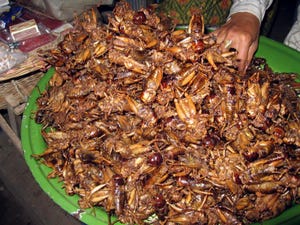
Cricket Consumption: Can edible insect products like Chapul Bars find a market?Cricket Consumption: Can edible insect products like Chapul Bars find a market?
A UN report and a New Yorker article got people excited about eating insects but the supply chain issues are far bigger than the market may ever be.

In George Orwell’s Animal Farm, the politics of the barnyard devolved into “Four legs good. Two legs bad.” Nobody ever mentioned six legs.
And yet, if a growing chorus of environmentally minded entrepreneurs finds success, those six legs will be crawling onto the dinner plate soon. Backed by a United Nations report suggesting insect consumption as a sustainability strategy to combat global hunger, and fueled by an insatiable appetite for novelty in foodie circles, these entrepreneurs are marching crickets—the “gateway bug” of packaged food—into energy bars and protein powders.
The reasoning is compelling. Insects produce protein efficiently with two pounds of feed producing 1 pound of crickets in contrast to a pound of beef that requires 8 pounds of feed. Insect farming uses a tenth of the water it takes to produce an equivalent weight in beef protein. The U.N. report also found that: “Insects are a highly nutritious and healthy food source with high fat, protein, vitamin, fiber and mineral content.” Mealworms are especially healthy—“The composition of unsaturated omega-3 and -6 fatty acids is comparable with that in fish.” Proponents eagerly point out that Americans are largely alone in shunning edible insects. The figure most commonly declared is that 80 percent of the world is eating bugs, with some species a coveted seasonal snacks in places like Mexico where the Washington Post reports a pound of giant winged ants can sell for $225.
Still, traditional, nutritional and environmental are all worthy concepts, but whether a significant chunk of the U.S. market will see cricket bars as innovation or infestation may depend less on what’s good for the planet and more on what’s good in a smoothie. Observers interviewed for this article believe it will take a “wow” experience to move insects out of the novelty bin and into the shopping cart on any regular basis. “If it doesn’t deliver any greater experience than the novelty, then what is the ultimate end?” asks food writer and trend watcher David Sax, author of The Tastemakers: Why We’re Crazy for Cupcakes but Fed Up with Fondue.
It may also depend on the economics. Crunching numbers on crunched-up insects does not cook up a solution-to-world-hunger picture. Not yet. A pound of cricket flour costs $30 at Texas-based World Ento. That’s wholesale. The June price on a pound of whey protein concentrate was $1.34. Beef hit an all-time high in June with per-pound commodity prices in the $2 range. Meanwhile, a sample pack of six Chapul Chaco Bars is $18 online, before shipping. An insectivore would need to eat a dozen bars and a bite or two of a 13th to hit the RDA for protein. And not all of it would come from crickets. Crickets are the fourth ingredient in Chapul’s Chaco Bar, after peanuts, a nut praised for its protein. The Bureau of Labor Statistics pegs the retail price of a pound of peanut butter at $2.66, meaning a shopper could buy more than 11 pounds of peanut butter for the price of one pound of cricket flour.
These are not exactly feed-the-world prices, although some in food production see real potential down the road as infrastructure scales up and prices drop. The U.N. report acknowledges the problem: “A major challenge of such industrial-scale rearing is the development of automation processes to make plants economically competitive with the production of meat (or meat substitutes like soy) from traditional livestock or farming processes.”
Early adapters
Proponents will say the prices reflect an industry in its infancy. It may be true that the rest of the world is eating bugs but much of that is wild harvested and seasonal. World Ento founder Harman Johar says his Austin-based company will ship 8,000 pounds of insect powder and cricket flour this year. He expects that to nearly quadruple next year and hit 30,000 pounds. For a company “operating with basically a college student’s beer budget,” the numbers are encouraging, Johar says. “We are finally hitting the sales that we need to start hitting,” he says, adding that he expects prices will drop below $20 “by the end of the year.” Johar goes on to predict “at least a $50 million industry in the next five years,” but he acknowledges that it will take people dedicated more to a cause than a business model. “The energy is out there. It just needs to be harnessed and focused.”
The energy, as Johar explains it, has not focused on making that $50 million, yet. The feed-the-world/save-the-planet ethic emerges as a driving principal. “The vast majority of us are here because we believe in making a difference socially and environmentally,” Johar says, describing Austin’s community of enthomophagy enthusiasts and entrepreneurs as “close-knit.” “Every insect company is a social enterprise,” he adds. A share of World Ento revenue profits will go to organizations in Africa teaching insect cultivation. Chapul pledges 10 percent of profits to water conservation.
The fact that the bug boosters appear to be coming from outside the food industry could also be telling. David Gordon Smith, author of The Eat-A-Bug Book, has promoted insect protein for 17 years. He sees enthusiasm and “momentum,” but he’s not sure he sees traction. “A lot of what is happening is start-ups—people who are either in college or just out of college,” Smith says. That demographic has changed the world before but changing the American palate may be trickier. “I am a little bit leary of saying this is going to happen,” Smith says. “I don’t see General Mills stepping up to the plate.”
Smith traces the recent surge in interest to a U.N. conference in 2009 on the feasibility of a bug-based food system and a 2011 New Yorker story. The article “really kickstarted that movement,” Smith says. “Everybody wanted to put their two bits in on why it was a good idea to eat bugs.” Historically, insect consumption as a model for food security is nothing new, even in the western world. In his 1885 pamphlet, Why Not Eat Insects?, Vincent Holt wrote: “I do not mean to pretend that the poor could live upon insects; but I do say that they might thus pleasantly and wholesomely vary their present diet.” Holt penned his treatise when the Irish potato famine was relatively recent, before mass starvation became a distant third-world phenomenon. Global warming, water shortages and land use add the urgency now.
Encouraging signs
Eric Woods, one of three founders at Bitty Foods, a San Francisco-based cricket cookie company, says business is good—“We’ve already had sales that are 165 percent of what we thought we would sell”—but it’s also complicated. “You can sort of plan for what other artisanal brand trajectories look like from scratch, to getting into major distribution, to going national, etc. But then you have to say, ‘How many of them actually had to create a new vertical?’” While Woods calls Bitty’s cookies a “frictionless way to introduce insect protein,” he knows the recipe is just one step in a long road to market. At this point, the three founders at Bitty are the entire work force. “The most challenging aspect for us I think is figuring out how to go from artisanal to industrial volume.”
Then there’s the gray area of regulation. “Everybody is worried about the FDA deciding at some point that they don’t want us to eat crickets,” Woods says.
Ricardo Carvajal, a lawyer with Hyman, Phelps & McNamara advising clients on FDA and FTC regulations, says that while the FDA has rules about how many bug parts can be in a food, those rules don’t apply if the bugs are the food. “In the absence of specific requirements, you would apply all the general umbrella regulations that apply to all foods,” Carvajal says, adding that all the FSMA rules of agricultural production would apply. Though he has heard of a FDA compliance officer stopping the import of an edible insect product because it wasn’t food, there was no legal basis. “The statutory definition of food is it’s a substance used for food,” he says, explaining that producers could point to documented histories of insect consumption.
That doesn’t mean the matter is settled. While USDA’s National Institute of Food & Agriculture Director Sonny Ramaswamy wrote in an email that “some of the requirements are that they are raised for that purpose, and not diverted from the pet food supplies, that they are raised in clean environments and devoid of contaminants, and that they are properly identified by scientific name. Apparently there are no additional regulations.” He also notes: “There’s also the issues pertaining to food safety that need to be borne in mind and addressed. If indeed we are going to have viable business enterprises of edible insects in the US, then FDA will need to help frame the regulations and policies.”
Johar says World Ento offers regulation guidance along with the cricket flour. He is in communication with the FDA and no FSMA issues have emerged, though he has advised all his customers that all packaging should be labeled with a shellfish allergy warning since crickets, like lobster and shrimp, are arthropods. The more complicated problems have come with chefs serving World Ento products in restaurants. High-end restaurants are catering to what the New Yorker story called “the America obsession with novelty,” but municipal health department inspectors may not be as enthusiastic. There have been long phone calls, Johar says. “We basically walk the health inspectors through the process.”
The costs and uncertainties have not discouraged the entrepreneurs, Johar says. World Ento is working with 20 startups. He has chosen not to compete against his customers in the bar market, but plans a finished product for the museum gift shop market that may emphasize novelty over nutrition. One of Johar’s customers, Charles Ceadal at Hopper Bar ATX, calls convincing people to eat bugs less of a challenge than learning to run a food business, but acknowledges consumers’ aversion. “The mass market needs to be exposed to three, four, five insect products before they will think it’s an acceptable product.”
Woods points out that the edible insect industry doesn’t need a whole aisle at Walmart. The environmentally aware—paleo dieters and athletes who see a benefit—could be enough. “If you add the numbers, you can have a real good business, even getting 10 percent of that market.”
Discouraging signs
Gregg Bagni at White Road Investments says it will take a lot more than a sampling station at Whole Foods. “Americans are not hungry enough to eat anything made with crickets. Period. End of paragraph.” Bagni theorizes that if Chapul approached White Road for backing, he'd probably stay clear. "Their vision and ideals are great, but they may be ahead of their time," he says. “In theory, we are extremely excited about new categories like this, especially considering it's an alternative to protein products like chicken or beef that require huge amounts of resources. I think these guys are on a mission, and we deeply respect that. We wish for them the best success, but I'm not sure it's a product that's right for North America at this time."
Bagni also questions if the mission mindset obscures the challenges. He wonders about edible insect advocates comparing eating bugs to eating sushi. Raw fish was a new concept to Americans 40 years ago, but those Americans were already eating fish. “Sushi and crickets are quite different,” says Bagni. He can’t think of a new food that faced such a challenge. Sure, hemp perceptually transformed from a noxious weed associated with an illegal drug to superfood, but edible insects are a different story. “On a scale of 1-10, hemp’s probably a 4. Crickets might be Spinal Tap volume 11 to the average American. It has super niche potential, but until ground beef hits $30 per lb, many will consider it a 'last resort.'"
Sax, winner of a James Beard Award for his food writing, concurs. “Given a choice, 99 percent of people are going to choose the chicken wing over the cricket wing every time.” That 1 percent may be generous. There is no compelling reason to go cricket, he explains. In the U.S., even the poor can find cheaper protein sources, and bugs are far from a taste sensation. Indeed, cricket is well down the ingredients list on Chapul bars, after conventional components like honey, dates and peanuts. “I have eaten insects and they don’t taste like anything,” Sax says. “For things to take off as food trends, even if they are healthy for you, they have to have that raw, everyday appeal.” Greek yogurt is a sensation because “it tastes better than regular yogurt,” Sax says. Kale “stays in your fridge longer than spinach, and it doesn’t wilt under heat.” If food choices were solely based on resources or nutrition and not taste, culture and tradition, there would be no restaurants, he says. “We would just have prison cafeterias.” According to Sax, insects will never go beyond a “subset” of environmentalists and a narrow slice of the fitness market. “Until your mother is eating cricket bars, it’s not going to be a mainstream trend.” He doesn’t see bugs as an investment strategy either, he says. “I’m shorting cricket and going long on chicken wings.”
It could be argued that the environmental argument will never be enough, until it is. The world is not without meat alternatives, many cheaper than conventional meats. Food innovators like the crews at Hampton Creek and Beyond Meat are producing vegan substitutes for eggs, chicken and beef, all cricket-free. The British scientists who cultured last year’s $345,000 test-tube burger believe the price of lab-grown meat can be scaled to be cheaper than beef with a tiny fraction of the environmental impact. Quinoa anybody?
There are quasi-believers, however, beyond the entrepreneurial set. University of Wyoming entomologist Jeffrey Lockwood believes in edible insects, especially fried grasshoppers. “That very thin wax layer on their body turns out to be an ideal layer for picking up flavors,” he says. But he’s also written a book on the revulsion they inspire: The Invested Mind: How Humans Think About Insects. The current flurry of interest is likely another peak in a cycle he’s seen before, Lockwood says. Factors from food scarcity to the internet could provide better traction than the previous cycles, but he doesn’t see a tipping point. “There’s that historical and cultural hill to climb, and I am not sure how we get over that hill. Environmental awareness and food scarcity do not necessarily create a compelling eating experience. “A person could be enticed to eat it the first time,” Lockwood says, “but that first time better be awfully good.”
About the Author
You May Also Like





